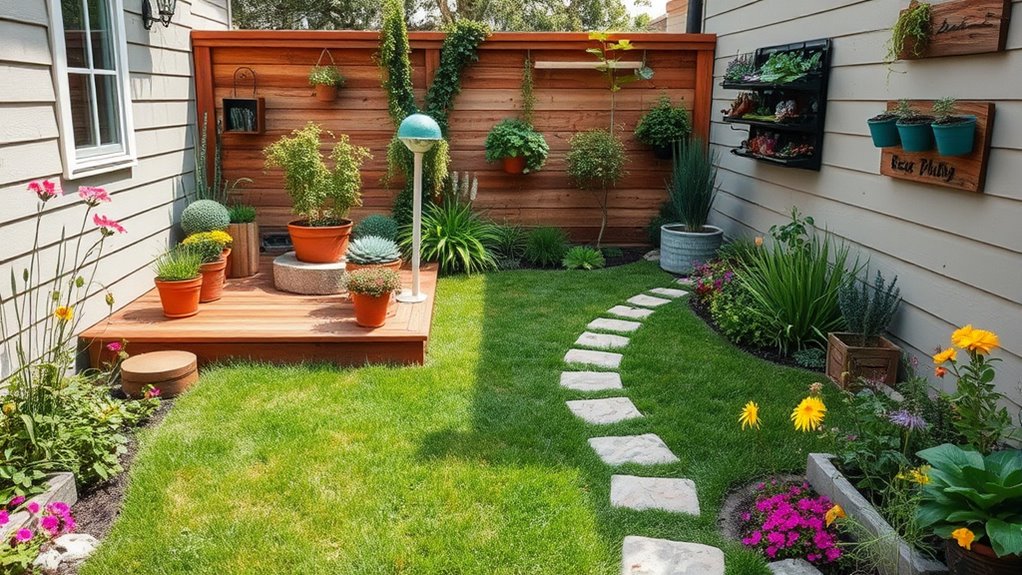To maximize small outdoor spaces for your tiny home, consider adding rooftop gardens using lightweight containers and native plants that thrive with minimal resources. Incorporate vertical gardening solutions like wall planters to expand growing areas without crowding. At ground level, use native ground covers and layered plantings to create depth and visual interest. Focus on sustainable, low-maintenance choices that support local pollinators, and explore creative layout tips to transform your outdoor area into a lush, functional retreat—more ideas await to inspire your space.
Key Takeaways
- Utilize rooftop gardens with native, drought-tolerant plants to maximize space and create private, eco-friendly retreats.
- Incorporate vertical gardening solutions like wall planters to expand planting area without occupying ground space.
- Choose native plants for ground-level landscaping to reduce maintenance, water use, and support local ecosystems.
- Layer plants of varying heights and textures to add visual interest and depth in limited outdoor areas.
- Design with environmental factors in mind, balancing aesthetics and functionality for a sustainable tiny home landscape.

Designing a landscape for a tiny home presents unique challenges and opportunities that can substantially enhance your outdoor space. One of the most innovative ways to maximize limited area is by creating a rooftop garden. Not only does this add visual interest, but it also offers a private retreat where you can relax, entertain, or grow fresh herbs and vegetables. To make the most of this space, choose lightweight containers and plan your layout carefully, considering sun exposure, wind, and weight limits. Incorporate native plants into your rooftop garden, as they’re adapted to your local climate, require less maintenance, and support local ecosystems. Native plants also tend to thrive without excessive watering or fertilizing, helping you create a sustainable, low-maintenance garden that looks beautiful year-round. native plants are an excellent choice because they are naturally suited to your environment, promoting healthier growth and reducing resource use.
Maximize your tiny home with a sustainable rooftop garden using native, low-maintenance plants.
When selecting native plants, think about their growth habits and how they will fit into your rooftop design. Opt for hardy grasses, drought-tolerant shrubs, or flowering perennials that can withstand the conditions up there. Mixing different textures and colors will create visual interest without overcrowding the space. You might also consider vertical gardening options like wall planters or trellises, which allow you to grow climbing plants or herbs without taking up valuable floor space. These strategies can transform a small rooftop into a lush, functional oasis that maximizes your tiny home’s footprint.
In addition to rooftop gardens, integrating native plants into ground-level landscaping can further amplify your outdoor appeal. Native plants require less water, fewer pesticides, and less overall attention, making them ideal for busy or inexperienced gardeners. They also attract local pollinators like bees and butterflies, enriching your garden’s ecosystem. For tiny home landscapes, choose compact varieties or plants that can be easily contained within small beds or containers. Layering plants of different heights and textures creates depth and visual interest without crowding the space.
Think about incorporating native ground covers or low-growing shrubs that can serve as a foundation for more colorful or decorative plants. This approach keeps your yard feeling open and manageable, while still offering a lush environment. When planning your landscape, remember that simplicity works best in small spaces. Focus on a few key native plants and a thoughtful layout, and you’ll craft a landscape that’s both beautiful and functional, perfectly suited to your tiny home’s scale. By thoughtfully using rooftop gardens and native plants, you turn limited space into a vibrant, eco-friendly haven that reflects your style and respects the environment.
Frequently Asked Questions
How Can I Maximize Small Outdoor Spaces Effectively?
To maximize your small outdoor space, start by using vertical gardening to free up ground area and add greenery without clutter. Incorporate outdoor lighting to create a cozy ambiance and extend usability into the evening. Choose multi-functional furniture to save space, and keep clutter minimal for a clean look. Combining these strategies helps you make the most of limited outdoor space, making it feel larger and more inviting.
What Low-Maintenance Landscaping Options Are Best for Tiny Homes?
Imagine your yard as a blank canvas—succulent gardens and rock landscaping are perfect for a low-maintenance masterpiece. You can easily create these with drought-tolerant plants that thrive on minimal water, and rocks that add texture and structure without upkeep. These options not only save you time but also add visual interest, transforming your small outdoor space into a stunning, easy-to-care-for retreat.
Are There Eco-Friendly Landscaping Ideas Suitable for Tiny Homes?
Yes, you can create eco-friendly landscapes for your tiny home by using native plants that thrive naturally in your area, reducing water and maintenance needs. Incorporate rain gardens to manage runoff sustainably and support local ecosystems. These ideas not only minimize your environmental footprint but also add beauty and resilience to your outdoor space. Embracing native plants and rain gardens helps you maintain an eco-friendly, low-impact landscape that complements your tiny home’s charm.
How Can I Create Privacy in a Compact Outdoor Area?
Perfectly positioning privacy screens and planting lush, layered plant barriers helps you craft cozy, concealed corners in your compact outdoor space. You can use tall trellises topped with vibrant vines or dense shrubbery to block prying eyes and boost privacy. By blending bold greenery with clever screens, you create a cuddly, secluded sanctuary where you can relax, unwind, and enjoy your tiny home’s tranquil outdoor retreat without worry.
What Are Budget-Friendly Landscaping Tips for Tiny Home Gardens?
To create budget-friendly tiny home gardens, focus on simple garden decor like colorful pots and DIY planters. Use outdoor lighting such as solar-powered string lights or lanterns to add warmth and charm without extra cost. Incorporate native plants that thrive easily, and arrange them thoughtfully around your space. These tips make your garden inviting and stylish without breaking the bank.
Conclusion
Ultimately, transforming your tiny home’s outdoor space isn’t just about aesthetics; it’s about creating a sustainable, peaceful retreat. Some believe that integrating natural elements can even boost your mental well-being, aligning with eco-therapy theories. So, experiment with vertical gardens or native plants—you might find that a well-designed landscape doesn’t just look good but also nurtures your mind and environment. Embrace these ideas, and watch your tiny home transform into a true sanctuary.








